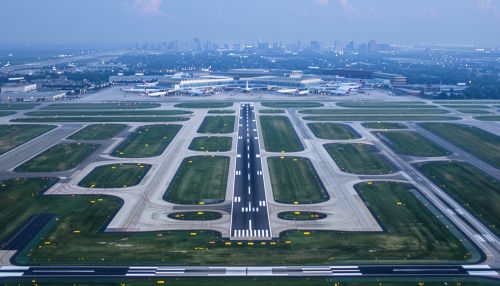Midway International Airport: Difference between revisions
(Created page with "== History == Midway International Airport, originally named Chicago Municipal Airport, was established in 1927 to serve the burgeoning aviation needs of the city of Chicago. The airport was renamed in 1949 to honor the Battle of Midway, a pivotal naval battle during World War II. Midway's development was driven by the rapid growth of commercial aviation and the need for a secondary airport to complement the larger O'Hare International Airport|O'Hare International Air...") |
No edit summary |
||
| Line 7: | Line 7: | ||
Midway International Airport is located on the southwest side of Chicago, approximately 8 miles from the Loop, the central business district of the city. The airport covers an area of 840 acres and features five runways. The primary runway, 13C/31C, is 6,522 feet long and 150 feet wide, capable of accommodating a wide range of aircraft. | Midway International Airport is located on the southwest side of Chicago, approximately 8 miles from the Loop, the central business district of the city. The airport covers an area of 840 acres and features five runways. The primary runway, 13C/31C, is 6,522 feet long and 150 feet wide, capable of accommodating a wide range of aircraft. | ||
[[Image:Detail-92157.jpg|thumb|center|Aerial view of Midway International Airport, showing runways, taxiways, and terminal buildings.|class=only_on_mobile]] | |||
[[Image:Detail-92158.jpg|thumb|center|Aerial view of Midway International Airport, showing runways, taxiways, and terminal buildings.|class=only_on_desktop]] | |||
The terminal complex at Midway consists of a single terminal building with three concourses (A, B, and C) and 43 gates. The terminal is equipped with modern amenities, including restaurants, shops, and lounges, to cater to the needs of passengers. | The terminal complex at Midway consists of a single terminal building with three concourses (A, B, and C) and 43 gates. The terminal is equipped with modern amenities, including restaurants, shops, and lounges, to cater to the needs of passengers. | ||
Latest revision as of 22:41, 17 June 2024
History
Midway International Airport, originally named Chicago Municipal Airport, was established in 1927 to serve the burgeoning aviation needs of the city of Chicago. The airport was renamed in 1949 to honor the Battle of Midway, a pivotal naval battle during World War II. Midway's development was driven by the rapid growth of commercial aviation and the need for a secondary airport to complement the larger O'Hare International Airport.
Location and Infrastructure
Midway International Airport is located on the southwest side of Chicago, approximately 8 miles from the Loop, the central business district of the city. The airport covers an area of 840 acres and features five runways. The primary runway, 13C/31C, is 6,522 feet long and 150 feet wide, capable of accommodating a wide range of aircraft.


The terminal complex at Midway consists of a single terminal building with three concourses (A, B, and C) and 43 gates. The terminal is equipped with modern amenities, including restaurants, shops, and lounges, to cater to the needs of passengers.
Operations and Airlines
Midway International Airport primarily serves domestic flights, with a focus on low-cost carriers. The airport is a major hub for Southwest Airlines, which operates the majority of flights from Midway. Other airlines operating at Midway include Delta Air Lines, Allegiant Air, and Porter Airlines.
The airport handles over 20 million passengers annually, making it one of the busiest airports in the United States. Midway's operations are supported by a robust ground transportation network, including the Chicago Transit Authority's Orange Line, which provides direct access to downtown Chicago.
Economic Impact
Midway International Airport plays a significant role in the local economy, generating billions of dollars in economic activity and supporting thousands of jobs. The airport's operations contribute to the growth of the aviation industry, tourism, and commerce in the Chicago metropolitan area.
The airport's economic impact extends beyond direct employment, as it supports numerous ancillary businesses, including hotels, restaurants, and retail establishments. Midway also serves as a critical hub for air cargo operations, facilitating the movement of goods and services both domestically and internationally.
Environmental Initiatives
Midway International Airport is committed to sustainability and environmental stewardship. The airport has implemented various initiatives to reduce its environmental footprint, including energy-efficient lighting, waste reduction programs, and water conservation measures. Midway also participates in the Chicago Department of Aviation's Sustainable Airport Manual, which provides guidelines for sustainable airport operations and development.
The airport has invested in green infrastructure, such as stormwater management systems and green roofs, to mitigate the impact of its operations on the surrounding environment. Additionally, Midway promotes the use of alternative fuels and electric vehicles to reduce greenhouse gas emissions.
Future Developments
Midway International Airport is undergoing a series of modernization projects to enhance its facilities and improve the passenger experience. The Midway Modernization Program, launched in 2015, includes the expansion of the terminal building, the addition of new gates, and upgrades to the airport's infrastructure.
The program aims to increase the airport's capacity and accommodate future growth in passenger traffic. The improvements will also enhance the airport's operational efficiency and ensure compliance with the latest safety and security standards.
